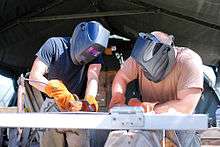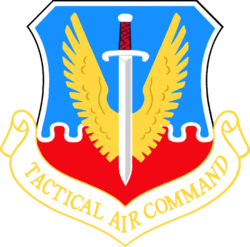474th Air Expeditionary Group
The 474th Air Expeditionary Group (474 AEG) is a provisional United States Air Force unit assigned to Air Combat Command. It may be activated or inactivated at any time.
| 474th Air Expeditionary Group | |
|---|---|
474th Air Expeditionary Group emblem | |
| Country | United States |
| Branch | United States Air Force |
| Commanders | |
| Notable commanders | Colonel John S. Loisel |

Currently, the 474 AEG is stationed at Davis–Monthan AFB, Arizona, and is deployed to Guantanamo Bay Naval Base Cuba. Its current mission and operational components are undetermined, however it appears to be primarily a Civil Engineering organization.
Its World War II predecessor unit, the 474th Fighter Group, was a Ninth Air Force combat unit which fought in the European Theater. First deployed to England, it provided tactical air support in support of U.S. First Army until V-E Day.
History
The 474th Fighter Group was constituted on 26 May 1943 and activated on 1 August 1943 at Glendale, California, flying Lockheed P-38 "Lightnings". It's component fighter squadrons were the 428th Fighter Squadron, 429th Fighter Squadron, and 430th Fighter Squadron. For the next several months the group trained for combat with the P-38s. The Group moved to England in February–March 1944 where it was assigned to Ninth Air Force.[1][2] The 474th was a group of Ninth Air Force's 70th Fighter Wing, IX Tactical Air Command.
The grass airfield and sandy soil at RAF Warmwell was considered suitable to support the 80 aircraft of a fighter group without metal tracking support. The personnel of the 474th Fighter Group arrived on 12 March from Oxnard Flight Strip, California flying Lockheed P-38 "Lightnings". Probably because they detrained at Moreton railway station, the group often referred to RAF Warmwell as Moreton. The 474th was a group of Ninth Air Force's 70th Fighter Wing, IX Tactical Air Command. Squadron markings on the vertical tail surfaces were a square and "F5" for the 428th with call sign "Geyser", a triangle and "Y7" for the 429th with call sign "Retail", and a circle and "K6" for the 430th with call sign "Back Door".[3][4] The 474th FG was the only one of the three Ninth Air Force groups equipped with the P-38 in England that had trained with the type in the United States.
The 474th carried out its first mission on 25 April with a sweep along the French coast. The P-38's ability to carry two 1,000 lb bombs with ease, and its heavy nose-mounted armament, made it an excellent ground attack aircraft, although it appeared to be far more vulnerable to light anti-aircraft and small arms fire than the redoubtable P-47. During 15 weeks of operations from Warmwell, 27 P-38s were missing in action, all but five known or suspected lost due to ground fire. Three of these were lost to a 'bounce' by Fw 190s while escorting B-26s on 7 May.
On the night of 5/6 June, the group flew patrols over the invasion fleet and the two aircraft lost are believed to have collided. On the credit side, during an armed reconnaissance on 18 July, a 474th formation led by Lieutenant Colonel Henry Darling surprised a force of bomb-carrying Focke-Wulf Fw 190s and shot down 10 Luftwaffe aircraft with the loss of only one P-38.
The 474th FG was the last of the Ninth Air Force's 18 fighter groups to move to an Advanced Landing Ground (ALG) in France, departing from Warmwell for St. Lambert, France (ALG A-11) during the first week of August 1944, the main body of aircraft departing on 6 August. The last mission from Warmwell, the group's 108th, was flown on the previous day.
The group continued operations on the continent providing tactical air support in support of U.S. First Army until V-E Day, being stationed at Bad Langensalza, Germany (ALG R-2) at the end of hostilities. The 474th FG returned to Camp Kilmer, New Jersey during November 1945 and was inactivated on 8 December 1945.
Cold War
The 474th Fighter Bomber Wing (FBW) was reactivated at Misawa AB, Japan, taking over the personnel and Republic F-84G Thunderjets of the Air National Guard 116th Fighter-Bomber Wing in July 1952 when the ANG was returned to state control. The wing was immediately ordered to Kunsan Air Base (K-8). From Kunsan the wing entered combat in August 1952 and bombed and strafed bridges, bunkers, troop concentrations, artillery positions, and a host of other targets.
On 16 March 1953 FEAF put into effect a new concept of a fighter-bomber wing (reinforced) to ease maintenance and support problems. In April 1953, the 49th FBW was relocated to K-8 (Kunsan) – in name only—for two of its squadrons. The 428 Kunsan became the 7th FBS; and the 429th became the 8th FBS. Its 9th FBS was relocated to Misawa Air Base, Japan. The 430th of Kunsan was physically relocated with all personnel, equipment and aircraft to Taegu to replace the 9th.
In the end, the 474th at Taegu had three squadrons, while the 49th at Kunsan had two squadrons. The 474th exchanged aircraft and personnel with the 49th Fighter Bomber Wing. In early summer 1953, these two wings were combined into the 58th Fighter bomber Wing (Reinforced) and the 474th and 49th Wings were placed on inactive status. The 58th FB Wing then relocated to Tageu AB (K-2) South Korea.
For its actions in the Korean War, the 474th Fighter Bomber Group received the Presidential Unit Citation and the Republic of Korea Presidential Unit Citation.
Moved to the US, November–December 1954, and became operational training unit for F-100 aircraft for the 312th Fighter-Bomber Wing at Clovis AFB, New Mexico. It was inactivated in 1958 when the group was elevated to wing status as the 474th Fighter-Bomber Wing. Discontinued as part of Air Force Tri-Deputate organization.
The 474th Tactical Fighter Wing (TFW) was activated in the United States in October 1957 and it maintained proficiency in tactical fighter operations, deploying components, aircraft, and crews on a global basis in support of NATO, Pacific Air Forces, Alaskan Air Command, and other organizations. The Wing deployed three squadrons to southeastern United States during the Cuban Missile Crisis of 1962. The entire wing, except for a deployed squadron in Southeast Asia, reverted to "paper" status on 15 September 1965, and the single detached squadron being reduced to "paper" status upon its return to the United States.
On 20 January 1968 the 474th Tactical Fighter Wing was activated at Nellis Air Force Base, Nevada from the 4480th TFW, giving the base an operational F-111A tactical fighter wing assigned to Twelfth Air Force. The 474th supported two deployments (1968, 1972-1973) to Takhli Royal Thai Air Force Base, conducting strike operations in North Vietnam, Laos, and Cambodia in the Vietnam War. The 474th flew slightly more than 4000 combat missions between late September 1972 and mid-March 1973 with excellent success rates in hitting targets even when visibility was near zero. A total of six aircraft were lost in action. The 474th was awarded the Air Force Outstanding Unit Award with Combat "V" Device 28 Sep 1972-22 Feb 1973[5] and Republic of Vietnam Gallantry Cross with Palm 28 Sep 1972-22 Feb 1973.[6]The last operational F-111As left Nellis for Mountain Home AFB on 2 August 1977 and on 5 August the F-111 aircraft and crews were transferred to the 366th Tactical Fighter Wing, Mountain Home AFB, Idaho, as part of "Operation Ready Switch". The 474th Wing absorbed the McDonnell F-4 Phantom II aircraft, crews, and resources of the inactivating provisional 4474th Tactical Fighter Wing at Nellis in April 1977, as part of "Operation Ready Switch". The F-4D Phantoms had a relatively short life, being replaced with new General Dynamics F-16A Fighting Falcons. The wing conducted routine Tactical Air Command training and deployments from Nellis with the F-16s until September 1989, when the wing was inactivated.
Post Cold War
Activated as 474th Air Expeditionary Group by Air Combat Command at Davis–Monthan AFB, Arizona. Mission and units undetermined.
Lineage
- Constituted as 474th Fighter Group on 26 May 1943
- Activated on 1 August 1943
- Inactivated on 8 December 1945
- Redesignated 474th Fighter-Bomber Group
- Activated in Japan on 10 July 1952
- Inactivated on 1 July 1958
- Redesignated 474th Tactical Fighter Wing in October 1957
- Reverted to paper status 15 September 1965
- Reactivated 20 January 1968
- Redesignated: 474th Tactical Fighter Group on 31 July 1985
- Inactivated in September 1989
- Redesignated 474th Air Expeditionary Group and converted to provisional status (Date TBD)
Assignments
- IV Fighter Command, 1 August 1943
- Attached to: Los Angeles Fighter Wing, 11 October 1943 – 6 February 1944
- IX Fighter Command, 12 March 1944
- 70th Fighter Wing, 1 August 1944
- Attached to: IX Tactical Air Command, 1 August 1944 – 21 November 1945
- Army Service Forces (for inactivation), 6–8 December 1945
- 474th Fighter-Bomber Wing, 25 June 1952 – 8 November 1954
- Attached to: Far East Air Forces, 1 April 1953
- Further Attached to: Fifth Air Force
- 312th Fighter-Bomber Wing, 8 November 1954 – 8 October 1957
- Air Combat Command to activate or inactivate at any time, (Date TBD)
- Assigned to Twelfth Air Force
- Attached to: United States Southern Command Air Forces (AFSOUTH), Joint Task Force Guantanamo
Stations
|
|
Components
- 428th Fighter (later Fighter-Bomber) Squadron, 1 August 1943 – 8 December 1945, 10 July 1952 – 22 November 1954, 13 December 1954 – 1 July 1958, 15 September 1968 - 30 July 1973, 19 July 1975 - September 1989
- 429th Fighter (later Fighter-Bomber) Squadron, 1 August 1943 – 8 December 1945, 10 July 1952 – 22 November 1954, 13 December 1954 – 1 July 1958, 15 September 1968 - 30 July 1973, 19 July 1975 - September 1989
- 430th Fighter (later Fighter-Bomber) Squadron, 1 August 1943 – 8 December 1945, 10 July 1952 – 22 November 1954, 13 December 1954 – 1 July 1958, 15 September 1968 - September 1989
- 442nd Tactical Fighter Training Squadron. October 1969 - September 1989
- 478th Fighter-Bomber Squadron, 13 December 1954 – 1 July 1958
Aircraft
- P-38 Lightning, 1943–1945
- F-84 Thunderstreak, 1952–1953
- F-86 Sabre, 1953, 1954
- F-100 Super Sabre, 1954–1958
- F-111 Aardvark, 1968-1977
- F-4 Phantom II, 1977-1980
- F-16 Fighting Falcon, 1980-1989
![]()
References
- "474th Fighter Group". American Air Museum in Britain. Retrieved 5 July 2020.
- "474th Fighter Group". Army Air Corps Library and Museum. Retrieved 30 June 2020.
- "474th Fighter Group". American Air Museum in Britain. Retrieved 5 July 2020.
- "474th Fighter Group". Army Air Corps Library and Museum. Retrieved 30 June 2020.
- Jones (30 June 1976). "Air Force Outstanding Unit Award (with Combat V Device)". Special Order GB-489: 1.
- Jones (1977). "Award of the Republic of Vietnam Galantry Cross with Palm". Special Order GB-322: 1.
![]()
- "430 Expeditionary Electronic Combat Squadron (ACC)". Air Force Historical Research Agency. USAF. Retrieved 2 July 2020.
- "474th Fighter Group". American Air Museum in Britain. Retrieved 5 July 2020.
- "474th Fighter Group". Army Air Corps Library and Museum. Retrieved 30 June 2020.
- Johnson, David C. (1988), U.S. Army Air Forces Continental Airfields (ETO), D-Day to V-E Day; Research Division, USAF Historical Research Center, Maxwell AFB, Alabama.
- Maurer, Maurer (1983). Air Force Combat Units of World War II. Maxwell AFB, Alabama: Office of Air Force History. ISBN 0-89201-092-4.
- Ravenstein, Charles A. (1984). Air Force Combat Wings Lineage and Honors Histories 1947–1977. Maxwell AFB, Alabama: Office of Air Force History. ISBN 0-912799-12-9.
- Swindt, Karl (1 January 1978). 429th Fighter Squadron: The Retail Gang- European Theater, World War II, Limited Edition (1st ed.). Sacramento, CA: Heritage Publications.






.svg.png)
.svg.png)